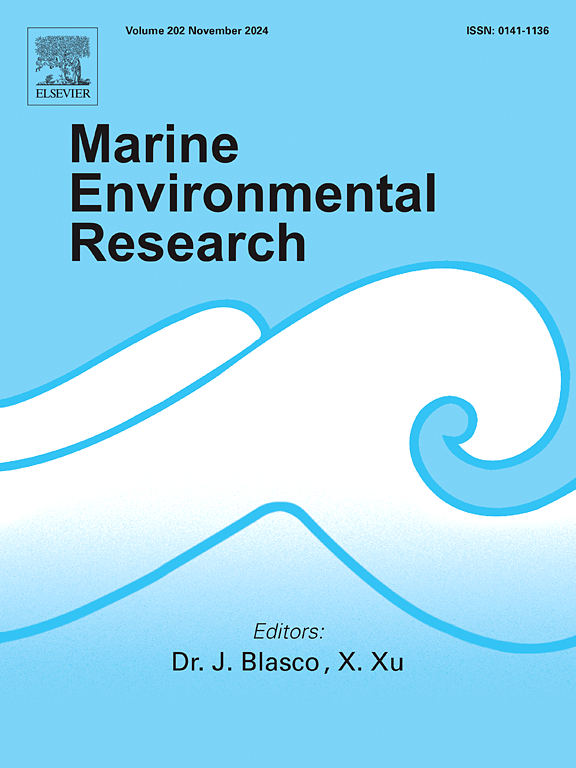印尼三宝垄湾生物地球化学变量记录及其潜在的海岸脱氧
IF 3
3区 环境科学与生态学
Q2 ENVIRONMENTAL SCIENCES
引用次数: 0
摘要
世界各地的沿海地区,包括印度尼西亚海域,正在经历溶解氧(DO)浓度下降,导致脱氧。三宝垄湾由于其半封闭的性质和大量的陆地输入,特别容易受到这种现象的影响。我们分析了生物地球化学变量的多年记录,包括营养物浓度、叶绿素-a (Chl-a)、表层和底层溶解氧(DO),以评估沿海脱氧的可能性。该研究特别关注底部DO,以了解其变异性及其对沉积物-水界面的潜在影响。目的是通过研究沉积物稳定同位素特征和生物地球化学变量记录及其对沉积物-水界面DO的潜在影响,评估海湾地区沿海脱氧的潜力。分析揭示了海面温度、海底温度和DO浓度的不同趋势。空间分析揭示了不同的模式,强调季风季节对温度、DO和Chl-a浓度的影响。该研究指出,DO和底部DO呈下降趋势(即分别为- 0.055和- 0.048 mmol/m3 /年),强调需要监测沉积物-水界面的溶解氧动态。地表沉积物的同位素分析表明,在特定的采样点,无论是否靠近海岸线或水深,都可能发生沉积物脱氧,在洪水通道中也有类似的迹象。这项研究为三宝垄湾沿海生物地球化学的复杂动态提供了有价值的见解。研究结果强调需要进一步研究,以完善模型和探索替代方法来解决已确定的限制,从而有助于加强研究地点的环境监测和评估。本文章由计算机程序翻译,如有差异,请以英文原文为准。
Records of biogeochemical variables for Semarang Bay, Indonesia, facing potential coastal deoxygenation
Coastal areas worldwide, including the Indonesian seas, are experiencing a decline in dissolved oxygen (DO) concentration, leading to deoxygenation. Semarang Bay, due to its semi-enclosed nature and significant terrestrial input, is particularly vulnerable to this phenomenon. We analyzed multi-annual records of biogeochemical variables, including nutrient concentrations, chlorophyll-a (Chl-a), and both surface and bottom dissolved oxygen (DO), to assess the possibility of coastal deoxygenation. The study focuses specifically on bottom DO to understand its variability and potential impact on the sediment-water interface. It aims to evaluate the potential for coastal deoxygenation in the bay region by examining sediment stable isotope signatures and biogeochemical variable records in connection with their potential influence on DO at the sediment-water interface. The analysis reveals contrasting trends in sea surface temperature, bottom temperature, and DO concentrations. Spatial analysis uncovers distinct patterns, emphasizing the influence of monsoon seasons on temperature, DO, and Chl-a concentrations. The study notes a declining trend in DO and bottom DO (i.e., −0.055 and −0.048 mmol/m3 per year, respectively), underscoring the need to monitor dissolved oxygen dynamics at the sediment-water interface. Isotope analysis of surface sediment suggests potential sediment deoxygenation at specific sampling sites, irrespective of proximity to the shoreline or bathymetric depth, with similar indications in flood channels. This research offers valuable insights into the complex dynamics of coastal biogeochemistry in Semarang Bay. The findings underscore the need for further research to refine models and explore alternative approaches to address the identified limitations, thereby contributing to enhanced environmental monitoring and assessment in the study site.
求助全文
通过发布文献求助,成功后即可免费获取论文全文。
去求助
来源期刊

Marine environmental research
环境科学-毒理学
CiteScore
5.90
自引率
3.00%
发文量
217
审稿时长
46 days
期刊介绍:
Marine Environmental Research publishes original research papers on chemical, physical, and biological interactions in the oceans and coastal waters. The journal serves as a forum for new information on biology, chemistry, and toxicology and syntheses that advance understanding of marine environmental processes.
Submission of multidisciplinary studies is encouraged. Studies that utilize experimental approaches to clarify the roles of anthropogenic and natural causes of changes in marine ecosystems are especially welcome, as are those studies that represent new developments of a theoretical or conceptual aspect of marine science. All papers published in this journal are reviewed by qualified peers prior to acceptance and publication. Examples of topics considered to be appropriate for the journal include, but are not limited to, the following:
– The extent, persistence, and consequences of change and the recovery from such change in natural marine systems
– The biochemical, physiological, and ecological consequences of contaminants to marine organisms and ecosystems
– The biogeochemistry of naturally occurring and anthropogenic substances
– Models that describe and predict the above processes
– Monitoring studies, to the extent that their results provide new information on functional processes
– Methodological papers describing improved quantitative techniques for the marine sciences.
 求助内容:
求助内容: 应助结果提醒方式:
应助结果提醒方式:


